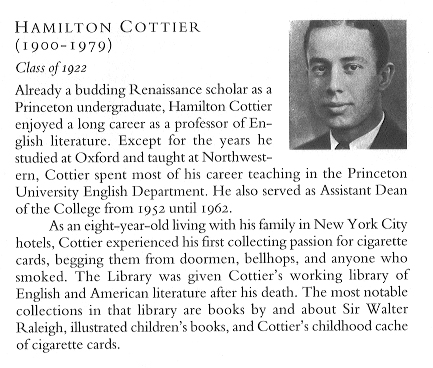
More:
Ann Seton Cottier -- later "Anya Seton," the popular novelist of meticulously researched historical novels (and daughter of Boy Scouts of America co-founder Edward Thomas Seton) -- married Hamilton Cottier. Here she is, the blushing bride:

According to Lucinda H. MacKethan: "Daughter Ann Cottier enjoyed a stimulating intellectual life with her husband in Oxford and then returned with him to Princeton, New Jersey to become an increasingly unhappy faculty wife. By 1929, the Seton family identity had been violently ruptured, resembling Little Peequo itself, a house that had been built haphazardly, expanded at odd angles, and scarred by fire in 1922."
And the following appeared in Time magazine (Monday, 17 Feb. 1930):
"Sued for divorce. Hamilton Cottier, Princeton English instructor; by Mrs. Ann Seton Cottier, daughter of Ernest Thompson Seton (woodcrafty author); at Reno. Grounds: mental cruelty."
Funny (or at least that's one word for it) that some very slight vestige of this "mental cruelty" might (might - i'm trying not to libel here) stretch down to some random stack-searcher, getting one last book as the work day winds down on a Tuesday nearly a century later.
A different, distinguished faculty member, Prof. John Fleming, had this to say in a column for the Princetonian (3/24/03): "A single grim subject occupies my mind; but my unimportant opinions about events in Iraq would amount to no more than another teardrop in the bucket, or rather sea of troubles on which our lumbering ship of state is now tossed. I'm facing writing deadlines, and I have been sticking to Firestone Library, where I continue to be amazed at what one can find in books."
Here here! Prof. Fleming goes on to find the signatures of interesting ex-faculty in our library, including that of H. Cottier in the Variorum Spenser. But there's more to find: Racism, lurid prying into the lives of ex-faculty, an upsetting inability to decipher whether the note is in the hand of this ex-prof. or that of some nameless student (since the volume appears to have been bought, for $1.20, at the University Store). What can't one find in these books?
